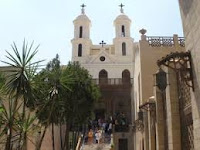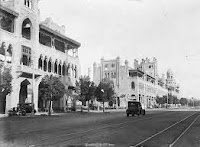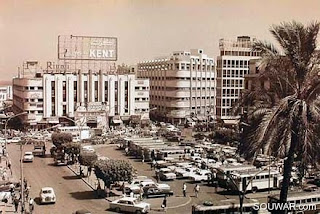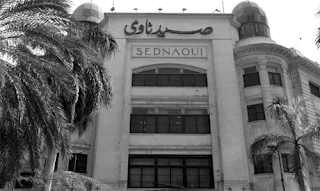Molokheya is the name of a plant found in the ancient Mediterranean languages such as Arabic and Greek. Cognates of the word include Ancient Greek μαλάχη (malákhē) or μολόχη (molókhē), Modern Greek μολόχα (molókha), modern Arabic: ملوخية (mulukhiyah) and Modern Hebrew: מלוחיה (malukhia).
A story about the name is claimed to be invented for a King (Malik) meal - Molokia or (Kingly) named by a cook that made the meal for a king how like it so much that it was called Molukia. (unlikely true but sounds good)
Mulukhiyah are the leaves of Corchorus olitorius, commonly known in English as denje'c'jute, nalta jute, tossa jute, jute mallow or Jew's Mallow. It is used as a vegetable and is popular in Middle East, East African, West African and North African countries and is called “Saluyot” in the Philippines. Mulukhiyah is rather bitter, and when boiled, the resulting liquid is a thick, highly mucilaginous broth; it is often described as "slimy", rather like cooked okra. Mulukhiyah is generally eaten cooked, not raw, and is most frequently turned into a kind of soup or stew, typically bearing the same name as the vegetable in the local language. Traditionally mulukhiyah is cooked with chicken or at least chicken stock for flavor and is served with white rice, accompanied by lemon or lime.
Origins and history
While most scholars are of the opinion that mulukhiyah's origins lie in Ancient Egypt, there is evidence that India is the source of the related species Corchorus capsularis, which is also used for food as well as fiber.
Culinary varieties.
Egyptian cuisine
Molokhiya was consumed in ancient Egyptian cuisine, where the name "molokhiya" is thought to have originated.
Many Egyptians consider molokhiya to be the national dish of Egypt, along with ful medames and kushari.
The Egyptian style of preparing molokhiya is distinctive, and is particularly different from the Levantine variant. The molokhiya leaves are picked off the stem, with tall stemmed branches. They are washed then placed on a large sheet (cloth material) to be left to completely dry for later use.
The soup is served with white rice and/or with a side of Egyptian flatbread (ʿeish baladi). The dish is often accompanied with an assortment of pickled vegetables, known as mekhallel or torshi in Egypt. Tomato sauce, vinegar, and other condiments may also be present. Chopped onions in vinegar is a must.
In the Egyptian cuisine, the molokhia dish generally includes some sort of meat usually chicken or rabbit, but lamb is preferred when available, particularly in Cairo. Cooks in Alexandria often opt for shrimp in the soup, while Port Said is famous for using fish.
It is worth mentioning that no two families eat Mulukhia the same way, soup first or rice first, crumbled toasted bead or soft bread, tomato sauce first or vinegar/lemon first or both ? but always when all the family is present.
Levantine style Mulukhiya
The standard molokhia dish in the Levant is prepared by cooking meat of some sort in a separate pot by boiling. Later onions and garlic are cooked to a simmer and then water and chicken stock cubes are added to form a broth. After boiling, the cooked chicken or meat with the broth coriander and molokhia leaves are added and further cooked another 15 minutes. Also, in northern Lebanon, a dish called mloukhiye b zeit is made using fresh leaves and shoots of the Nalta jute plant, cooked in olive oil, onions, garlic, tomatoes and chili peppers; it is a popular summer side dish, especially in Miniyeh-Danniyeh and Akkar districts.
Bedouins have an old tradition of cooking a different version of the dish. A whole chicken is cut open, the intestines removed, and the innards stuffed with herbs, spices and raw rice then sewn shut with thick thread. The chicken is then boiled to create the broth for the molokhia soup which, after preparation, is served as five separate components: The molokhia soup, Arabic flat pita bread, the chicken (stuffed with flavored rice), additional plain rice, and a small bowl with a mixture of lemon juice and sliced chilli. The soup is mixed with rice and lemon juice according to taste, while the chicken is eaten on a separate plate.
Tunisian mloukhiya stew with meat.
In Tunisia, the dish is generally prepared quite differently from the Egyptian method. The leaves, already separated from the stems, are dried then ground to produce a very fine powder and stored in jars or other tightly closed containers. In Tunisian cooking, mulukhya, or mloukhiya, takes 5 to 7 hours to prepare, which is often done to halfway in the evening and completed in the morning.
Kenyan cuisine
In Kenya, the dish is known as murere (Luhya), murenda, apoth (Luo), and several other native language names. It is a very popular vegetable dish among communities in the Western region (Vihiga, Kakamega, Busia, Trans Nzoia and Bungoma Counties) and in Nyanza region (Kisumu, Siaya, Homa Bay, Kisii, Migori and Nyamira Counties). Both regions are in the area around Lake Victoria. The jute leaves are separated from the stems, washed, and then boiled in lightly salted water with ligadi (a raw form of bicarbonate of soda), or munyu (traditional plant-based salt). The leaves are boiled with other leafy vegetables such as likuvi Vigna unguiculata (cowpea) leaves or mito (Chipilín) to reduce their sliminess and help soften the other vegetable leaves. In some cases, after boiling for about thirty minutes, the vegetables are stewed with tomatoes and onions in oil. (There are several general ways to prepare the mutere and more ways in which it is served). Spices such as curry, pepper, masala, or coriander are optional. Mutere is served with ugali (a staple stuff, cooked cereal meal) and can be accompanied with meat or chicken.
West African cuisines
The leaf is a common food in many tropical West African countries. It is believed that the "drip tips" on the leaves serve to shed excess water from the leaf from the heavy rains in the tropics. In Sierra Leone it is called kren-kre (krain krain or crain crain), and is eaten in a palm oil sauce served with rice or cassava fufu (a traditional food made from cassava), or else is steamed and mixed into rice just before eating a non-palm oil sauce. Among the Yorubas in south-west Nigeria, it is called ewedu and served with cooked yam flour (amala). In Liberia it is called palaver sauce, and is served with rice or fufu. In The Gambia it is referred to as kereng-kereng and is typically used to make supakanja (a dish mostly served on Saturdays and made with okra, red palm oil, fish and meat).
In Ghana, it is known as Ademe ewe or Ayoyo leaves and used to make accompanying soups for Banku (a corn cassavas dough dish) or cooked rice).
Cypriot cuisine
Haitian cuisine
Nutrition
The leaves are rich in folate, beta-carotene, iron, calcium, vitamin C and more than 32 vitamins, minerals like Magnesium and trace elements. The plant has a potent antioxidant activity with a significant α-tocopherol equivalent vitamin E.
The Magnesium content is known to trigger the release of hormones that relax the body and calm nerves.
There is an article about Molokhia in my blog (February 2015) that relates to a poem written in 2014 by Mario Vicchi (Rome), alias Marius d'Alexandrie. Have a look...













































